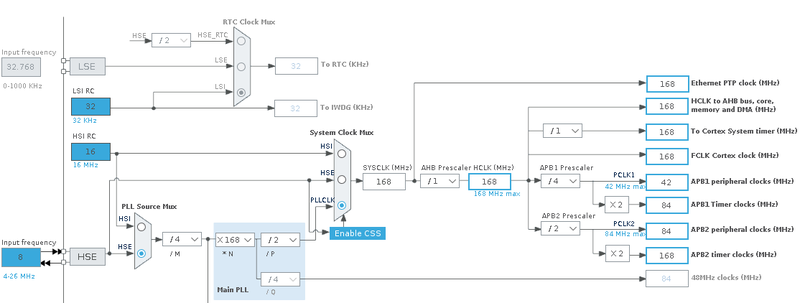Difference between revisions of "STM32 Audio Analogue ADC and DAC using Timer + DMA"
Jump to navigation
Jump to search
imported>Lth |
imported>Lth |
||
| Line 1: | Line 1: | ||
[[Category:STM32]][[Category:ADC]][[Category:DAC]][[Category:DMA]] | [[Category:STM32]][[Category:ADC]][[Category:DAC]][[Category:DMA]] | ||
| − | This page deals with running the STM32 ADCs and DACs off of a timer | + | This page deals with running the STM32 ADCs and DACs off of a timer at a sample rate adequate for Audio Data. We will be using a sample rate of 48000 Hz for both. |
| + | |||
| + | == Configuring Clocks == | ||
| + | |||
| + | For this we'll be using a [[stm32dev]] board which is equipped with a STM32F405RG processor and a 8 MHz external crystal. | ||
| + | |||
| + | Using [[STM32CubeMx]] the clocks are configured like this: | ||
| + | |||
| + | [[File:ADCDAC Example Clock.png|800px]] | ||
| + | |||
| + | As can be seen, the processor is using the external (HSE) crystal running at 8 MHz, to generate it's internal SYSCLK running at 168 MHz. From this clock the two timer clocks are derived, APB1 timer running at 84 MHz and APB2 timer at 168 MHz. | ||
| + | |||
| + | == Configuring Timer for Audio Sampling == | ||
| + | |||
| + | As mentioned earlier we are aiming for a sample rate of 48 kHz - which should be adequate for audible audio. | ||
Revision as of 07:45, 21 November 2020
This page deals with running the STM32 ADCs and DACs off of a timer at a sample rate adequate for Audio Data. We will be using a sample rate of 48000 Hz for both.
Configuring Clocks
For this we'll be using a stm32dev board which is equipped with a STM32F405RG processor and a 8 MHz external crystal.
Using STM32CubeMx the clocks are configured like this:
As can be seen, the processor is using the external (HSE) crystal running at 8 MHz, to generate it's internal SYSCLK running at 168 MHz. From this clock the two timer clocks are derived, APB1 timer running at 84 MHz and APB2 timer at 168 MHz.
Configuring Timer for Audio Sampling
As mentioned earlier we are aiming for a sample rate of 48 kHz - which should be adequate for audible audio.
